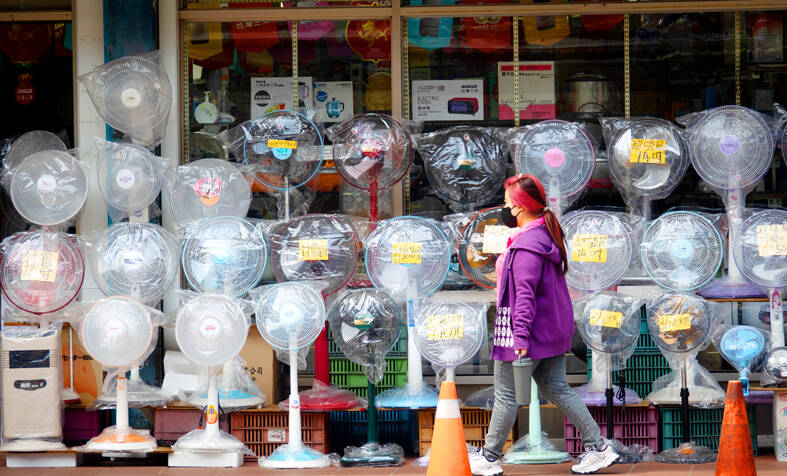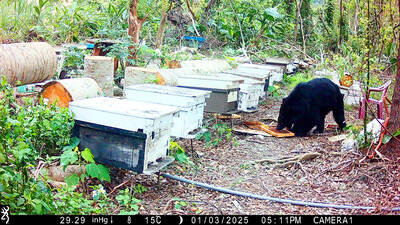Electricity rates are to rise for most people from today as part of a series of structured hikes determined by the Electricity Tariff Examination Council of the Ministry of Economic Affairs on March 22.
According to current consumption, about 9.08 million households (about 68 percent), are to face a hike of 3 percent, while another 3.42 million (about 26 percent), are to face a rise of 5 percent. The remaining households are to see 7 to 10 percent hikes.
During the summer, when households consume more electricity, the state-owned Taiwan Power Co (Taipower) said that about two-thirds of Taiwanese households would incur about NT$700 in monthly electricity costs.

Photo: CNA
After the rate adjustments, which take effect today, such consumers are to see an increase of about NT$21 in their monthly electricity fees, less than NT$1 per day, in the summer, the company said.
The agriculture and fishery sectors, as well as schools and social welfare organizations, are the only groups whose electricity rates have been frozen.
While hospitals are to see their rates rise, the Cabinet decided on Friday to subsidize electricity costs for district hospitals, which would be most affected by the rate hike, the Ministry of Health and Welfare said.
General industrial users are to face rate hikes of 7 to 14 percent. Data centers are to see hikes of 15 to 25 percent.
Major industrial consumers who saw an average increase in electricity use over the past two years and consume more than 500 gigawatt-hours per year are to face hikes of 15 to 25 percent.
The plan was brought forward as Taipower faces an accumulated deficit of NT$382.6 billion (US$12 billion) as of the end of this year.
Without the rate adjustments, the state-run company would incur a further loss of NT$188.7 billion this year, Minister of Economic Affairs Wang Mei-hua (王美花) said.
With the rate adjustments and a NT$100 billion subsidy promised by the Cabinet, the anticipated loss is expected to drop to about NT$10 billion, Taipower said.

SHIPS, TRAINS AND AUTOMOBILES: The ministry has announced changes to varied transportation industries taking effect soon, with a number of effects for passengers Beginning next month, the post office is canceling signature upon delivery and written inquiry services for international registered small packets in accordance with the new policy of the Universal Postal Union, the Ministry of Transportation and Communications said yesterday. The new policy does not apply to packets that are to be delivered to China, the ministry said. Senders of international registered small packets would receive a NT$10 rebate on postage if the packets are sent from Jan. 1 to March 31, it added. The ministry said that three other policies are also scheduled to take effect next month. International cruise ship operators

HORROR STORIES: One victim recounted not realizing they had been stabbed and seeing people bleeding, while another recalled breaking down in tears after fleeing A man on Friday died after he tried to fight the knife-wielding suspect who went on a stabbing spree near two of Taipei’s busiest metro stations, Taipei Mayor Chiang Wan-an (蔣萬安) said. The 57-year-old man, identified by his family name, Yu (余), encountered the suspect at Exit M7 of Taipei Main Station and immediately tried to stop him, but was fatally wounded and later died, Chiang said, calling the incident “heartbreaking.” Yu’s family would receive at least NT$5 million (US$158,584) in compensation through the Taipei Rapid Transit Corp’s (TRTC) insurance coverage, he said after convening an emergency security response meeting yesterday morning. National

PLANNED: The suspect visited the crime scene before the killings, seeking information on how to access the roof, and had extensively researched a 2014 stabbing incident The suspect in a stabbing attack that killed three people and injured 11 in Taipei on Friday had planned the assault and set fires at other locations earlier in the day, law enforcement officials said yesterday. National Police Agency (NPA) Director-General Chang Jung-hsin (張榮興) said the suspect, a 27-year-old man named Chang Wen (張文), began the attacks at 3:40pm, first setting off smoke bombs on a road, damaging cars and motorbikes. Earlier, Chang Wen set fire to a rental room where he was staying on Gongyuan Road in Zhongzheng District (中正), Chang Jung-hsin said. The suspect later threw smoke grenades near two exits

The Forestry and Nature Conservation Agency yesterday launched a gift box to market honey “certified by a Formosan black bear” in appreciation of a beekeeper’s amicable interaction with a honey-thieving bear. Beekeeper Chih Ming-chen (池明鎮) in January inspected his bee farm in Hualien County’s Jhuosi Township (卓溪) and found that more than 20 beehives had been destroyed and many hives were eaten, with bear droppings and paw prints near the destroyed hives, the agency said. Chih returned to the farm to move the remaining beehives away that evening when he encountered a Formosan black bear only 20m away, the agency said. The bear